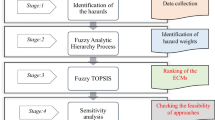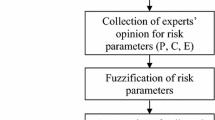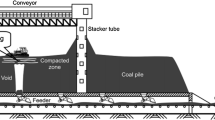Abstract
Despite being crucial for meeting the world’s energy demands, coal mining operations present considerable health risks, especially when it comes to exposure to coal dust. Longwall coal mining, an advanced technique, has considerably enhanced production but made dust control more difficult. Due to its explosive nature, coal dust continues to be a serious and dangerous concern in the industry despite developments in safety technology. This study aims to comprehensively assess the risk of coal dust explosions by integrating fuzzy risk matrix and Pareto analysis methodologies, offering precise risk ratings for various root causes. A fuzzy risk matrix was developed to assign exact risk ratings to identified root causes. Additionally, a Pareto chart was used to identify the main reasons and suggest particular preventive measures. 17 significant causes were determined for underground coal mines based on the study’s methodology, and some preventive measures were suggested. In accordance with fuzzy risk rating values, root causes were divided into six categories. The root hazard with the highest risk rating was identified as ‘accumulation of inflammable gas/gases’. The proposed approach was used to examine incidents caused by coal dust explosions in Turkish coal mines in order to demonstrate the effectiveness of combining the fuzzy risk matrix and Pareto analysis for assessing coal dust explosions. This study gives not only a solid framework for risk assessment but also critical information for classifying the risks associated with coal mine dust explosions. The results highlight the critical necessity for proactive and preventive actions to reduce the hazards of coal dust explosions and protect the safety of mining workers.









Similar content being viewed by others
Data Availability
All data are currently presented in the manuscript.
Abbreviations
- FIS :
-
Fuzzy inference system
- FRM :
-
Fuzzy risk matrix
- FRR :
-
Fuzzy risk rating
- FRR C :
-
Cumulative fuzzy risk rating
- FRR P :
-
Percentage of cumulative fuzzy risk rating
- P :
-
Likelihood
- R :
-
Risk rating
- S :
-
Severity
References
Kursunoglu N, Gogebakan M (2022) Prediction of spontaneous coal combustion tendency using multinomial logistic regression. Int J Occup Saf Ergon 28(4):2000–2009
Kursunoglu N, Onder S, Onder M (2022) The evaluation of personal protective equipment usage habit of mining employees using structural equation modeling. Saf Health Work 13(2):180–186
Wang H, Li J, Wang D, Huang Z (2017) A novel method of fuzzy fault tree analysis combined with VB program to identify and assess the risk of coal dust explosions. PLoS ONE 12(8):e0182453
Medic Pejic L, García Torrent J, Querol E, Lebecki K (2013) A new simple methodology for evaluation of explosion risk in underground coal mines. J Loss Prev Process Ind 26(6):1524–1529
Zhou S (2013) Application of fault tree analysis in coal mine fire accidents. In: Proceedings of 2013 International Conference on Quality, Reliability, Risk, Maintenance, and Safety Engineering. Cheng du, China
Liu R, Cheng W, Yu Y, Xu Q (2018) Human factors analysis of major coal mine accidents in China based on the HFACS-CM model and AHP method. Int J Ind Ergon 68:270–279
Shi SL, Jiang BY, Meng XR (2018) Assessment of gas and dust explosion in coal mines by means of fuzzy fault tree analysis. Int J Min Sci Techno 28:991–998
Tong X, Fang W, Yuan S, Ma J, Bai Y (2018) Application of Bayesian approach to the assessment of mine gas explosion. J Loss Prev Process Ind 54:238–245
Bhattacharjee RM, Dash AK, Paul PS (2020) A root cause failure analysis of coal dust explosion disaster – gaps and lessons learnt. Eng Fail Anal 111:104229
Li HT, Deng J, Chen XK (2020) Qualitative and quantitative characterization for explosion severity and gaseous–solid residues during methane–coal particle hybrid explosions: an approach to estimating the safety degree for underground coal mines. Process Saf Environ Prot 141:150–166
Mutlu M, Sari M (2022) Risk-based classification of underground coal mine basins in Turkey using the analytic hierarchy process (AHP). Arab J Geosci 15(752):1–18
Marhavilas PK, Koulouriotis D, Gemeni V (2011) Risk analysis and assessment methodologies in the work sites: on a review, classification and comparative study of the scientific literature of the period 2000–2009. J Loss Prev Process Ind 24:477–523
Onder S, Suner N, Onder M (2011) Investigation of occupational accident occurred at mining sector by using risk assessment decision matrix. In: 22nd International Mining Congress and Exhibition of Turkey, Ankara pp. 399–406
Skorupski J (2016) The simulation-fuzzy method of assessing the risk of air traffic accidents using the fuzzy risk matrix. Saf Sci 88:76–87
Stamatis D (2004) Six sigma fundamentals; a complete guide to the system; methods, tools. Mcgraw-Hill, New York
Shikha V, Sharad C (2016) Highlights from the literature on risk assessment techniques adopted in the mining industry: a review of past contributions, recent developments and future scope. Int J Min Sci Technol 26(4):691–702
Samantra C, Datta S, Mahapatra SS (2017) Fuzzy based risk assessment module for metropolitan construction project: an empirical study. Eng Appl Artif Intell 65:449–464
Gul M, Guneri AF (2016) A fuzzy multi criteria risk assessment based on decision matrix technique: a case study for aluminum industry. J Loss Prev Process Ind 40:89–100
Zadeh LA (1965) Fuzzy sets. Inf Control 8(3):338–353
Jang RJS, Sun CT, Mizutani E (1997) Neuro-fuzzy and soft computing. Prentice-Hall, Upper Saddle River
Yen J, Langari R (1999) Fuzzy logic intelligence, control, and information. Prentice Hall, New Jersey
Gayathri BM, Sumathi CP (2015) Mamdani fuzzy inference system for breast cancer risk detection. International Conference on Computational Intelligence and Computing Research (ICCIC)
Mamdani EH, Assilian S (1975) An experiment in linguistic synthesis with a fuzzy controller. Int J Man Mach Stud 7(1):1–13
Faybishenko B, Sadiq R, Deshpande A (2023) Fuzzy systems modeling in environmental and health risk assessment. John Wiley & Sons, Inc., Hoboken
Chunmiao Y, Chang L, Gang L (2011) Coal dust explosion prevention and protection based on inherent safety. Procedia Eng 26:1517–1525
Lenné MG, Salmon PM, Liu CC, Trotter M (2012) A systems approach to accident causation in mining: an application of the HFACS method. Accid Anal Prev 48:111–117
Qiao W (2021) Analysis and measurement of multifactor risk in underground coal mine accidents based on coupling theory. Reliab Eng Syst 208:107433
Turkish Hard Coal Enterprise (2019) Disasters in mining operations and preventive actions. Occupational accident report (in Turkish)
Dubaniewicz TH Jr (2009) From Scotia to Brookwood, fatal US underground coal mine explosions ignited in intake air courses. J Loss Prev Process Ind 22(1):52–58
Gul M, Mete S, Serin F, Celik E (2021) Fine–Kinney-based fuzzy multi-criteria occupational risk assessment. Approaches, case studies and Python applications. Springer Nature Switzerland AG, Cham
Ministry of Labor and Social Security (2023) https://www.csgb.gov.tr/media/88086/yer-alti-ve-acik-komur-isletmeciliginde-tozla-mucadele-rehberi.pdf Accessed 1 Feb 2023
Yinlin J, Ting R, Peter W, Zhijun W, Zhaoyang M, Zhimin W (2016) A comparative study of dust control practices in Chinese and Australian longwall coal mines. Int J Min Sci Technol 26(2):199–208
Ray SK, Khan AM, Mohalik NK, Mishra D, Mandal S, Pandey JK (2022) Review of preventive and constructive measures for coal mine explosions: an Indian perspective. Int J Min Sci Technol 32(3):471–485
Colinet JF, Rider JP, Listak JM, Organiscak JA, Wolfe AL (2010) Best practices for dust control in coal mining. Department of Health and Human Services, DHHS (NIOSH) Publication No. 2010–110. Pittsburgh, PA
Thakur P (2018) Advanced mine ventilation: respirable coal dust, combustible gas and mine fire control. Woodhead Publishing, United Kingdom
Sahu A, Mishra DP (2023) Coal mine explosions in India: management failure, safety lapses and mitigative measures. Extr Ind Soc 14:101233
Acknowledgements
The author thanks the editors and anonymous reviewers for improving the manuscript.
Author information
Authors and Affiliations
Corresponding author
Ethics declarations
Conflict of Interest
The authors declare no competing interests.
Additional information
Publisher's Note
Springer Nature remains neutral with regard to jurisdictional claims in published maps and institutional affiliations.
Rights and permissions
Springer Nature or its licensor (e.g. a society or other partner) holds exclusive rights to this article under a publishing agreement with the author(s) or other rightsholder(s); author self-archiving of the accepted manuscript version of this article is solely governed by the terms of such publishing agreement and applicable law.
About this article
Cite this article
Kursunoglu, N. Risk Assessment of Coal Dust Explosions in Coal Mines Using a Combined Fuzzy Risk Matrix and Pareto Analysis Approach. Mining, Metallurgy & Exploration 40, 2305–2317 (2023). https://doi.org/10.1007/s42461-023-00878-z
Received:
Accepted:
Published:
Issue Date:
DOI: https://doi.org/10.1007/s42461-023-00878-z




